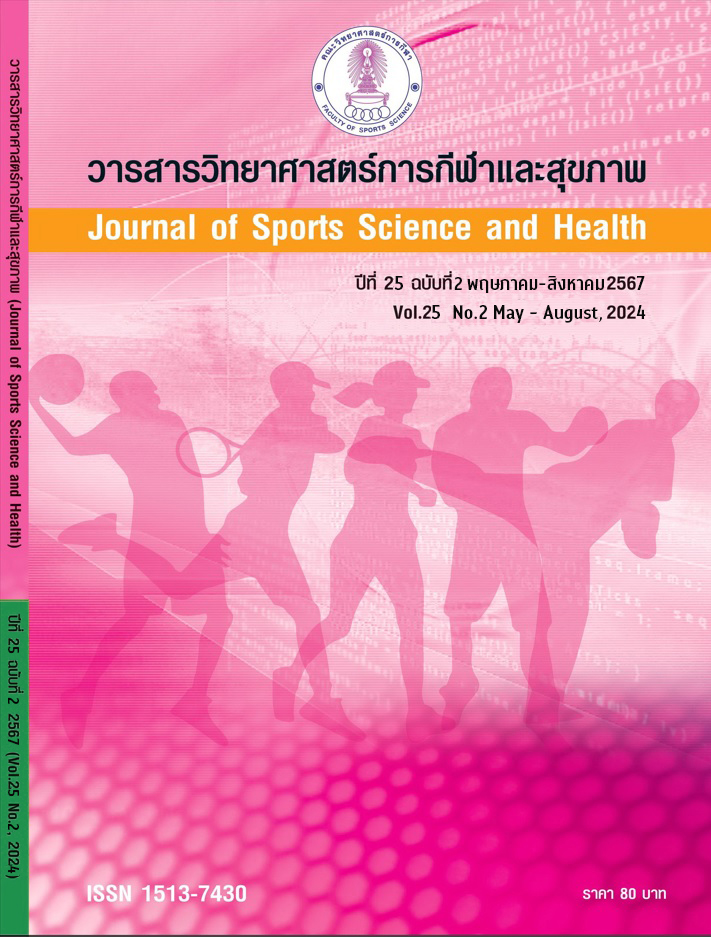ผลของการฝึกพลัยโอเมตริกร่วมกับการฝึกเปลี่ยนทิศทางแบบมีน้ำหนักถ่วงและไม่มีน้ำหนักถ่วง ที่มีต่อความสามารถทางสมรรถภาพทางกายในนักกีฬาฟุตบอลชาย
Main Article Content
บทคัดย่อ
วัตถุประสงค์
การวิจัยครั้งนี้มีวัตถุประสงค์เพื่อศึกษาและเปรียบเทียบผลของการฝึกพลัยโอเมตริกร่วมกับการฝึกเปลี่ยนทิศทางแบบมีน้ำหนักถ่วงและไม่มีน้ำหนักถ่วงที่มีต่อความสามารถทางสมรรถภาพทางกายในนักกีฬาฟุตบอลชาย
วิธีการดำเนินการวิจัย
คัดเลือกกลุ่มตัวอย่างแบบเฉพาะเจาะจง เป็นนักกีฬาฟุตบอลชาย อายุระหว่าง 18-25 ปี ที่ จำนวน 26 คน แบ่งกลุ่มตัวอย่างออกเป็น 2 กลุ่มๆ ละ 13 คน โดยวิธีจับคู่ด้วยความแข็งแรงสัมพัทธ์ โดยกลุ่มทดลองฝึกพลัยโอเมตริกร่วมกับการฝึกเปลี่ยนทิศทางแบบมีน้ำหนักถ่วง โดยใส่เสื้อถ่วงน้ำหนักที่ 8% ของน้ำหนักตัว และกลุ่มควบคุมฝึกพลัยโอเมตริกร่วมกับการฝึกเปลี่ยนทิศทางแบบไม่มีน้ำหนักถ่วง ฝึก 2 ครั้งต่อสัปดาห์ ระยะเวลา 8 สัปดาห์ ทำการทดสอบความแข็งแรง อัตราความเร็วสูงสุด พลังกล้ามเนื้อ ความคล่องแคล่วว่องไว และความสามารถด้านแอโรบิก ก่อนการฝึก หลังการฝึก 4 สัปดาห์ และหลังการฝึก 8 สัปดาห์ วิเคราะห์ข้อมูลทางสถิติ โดยภายในกลุ่มใช้สถิติการวิเคราะห์ความแปรปรวนทางเดียวชนิดวัดซ้ำ (One-way repeated measures ANOVA) เมื่อพบความแตกต่างจะทำการเปรียบเทียบความแตกต่างเป็นรายคู่โดยวิธีการของ Bonferroni และระหว่างกลุ่มใช้สถิติ Independent Sample t-test กำหนดความมีนัยสำคัญทางสถิติที่ 0.05
ผลการวิจัย
หลังการฝึก 8 สัปดาห์ พบว่า กลุ่มทดลองสามารถพัฒนาความสามารถทางสมรรถภาพทางกายได้ดีกว่ากลุ่มควบคุม อย่างมีนัยสำคัญทางสถิติที่ระดับ 0.05
หลังการฝึก 8 สัปดาห์ กลุ่มทดลองและกลุ่มควบคุมสามารถพัฒนาความสามารถทางสมรรถภาพทางกาย แตกต่างจากก่อนการฝึกและหลังการฝึก 4 สัปดาห์ อย่างมีนัยสำคัญทางสถิติที่ระดับ 0.05
สรุปผลการวิจัย
การฝึกพลัยโอเมตริกร่วมกับการฝึกเปลี่ยนทิศทางแบบมีน้ำหนักถ่วงสามารถเพิ่มความสามารถทางสมรรถภาพทางกาย จึงเหมาะสมที่จะนำไปฝึกซ้อมเพื่อพัฒนาสมรรถภาพร่างกายให้แก่นักกีฬาฟุตบอล
Article Details

อนุญาตภายใต้เงื่อนไข Creative Commons Attribution-NonCommercial-NoDerivatives 4.0 International License.
เอกสารอ้างอิง
Aloui, G, Hermassi, S, Hayes, L. D., Bouhafs, E. G., Chelly, M. S., Schwesig, R. (2021). Loaded plyometrics and short sprints with change-of-direction training enhance jumping, sprinting, agility, and balance performance of male soccer players. Applied Sciences, 11(12), 5587. https://doi.org/10.3390/app11125587
Brughelli, M., Cronin, J., Levin, G., and Chaouachi, A. (2008). Understanding change of direction ability in sport: a review of resistance training studies. Sports Medicine, 38(12), 1045-1063.
Buchheit, M., and Laursen, P. B. (2013). High-intensity interval training, solutions to the programming puzzle: Part I: cardiopulmonary emphasis. Sports Medicine, 43(5), 313-338.
Chaoplana, R., & Yimlamai, T. (2020). The effects of eccentric complex training on leg muscular performance in soccer players. Journal of Sports Science and Health, 21(3), 327-341.
Chaouachi, A., Manzi, V., Chaalali, A., Wong, delP., Chamari, K., and Castagna, C. (2012). Determinants analysis of change-of-direction ability in elite soccer players. Journal of Strength and Conditioning Research, 26(10), 2667-2676.
Chen, L., Zhang, Z., Huang, Z., Yang, Q., Gao, C., Ji, H., Sun, J., and Li, D. (2023). Meta-analysis of the effects of plyometric training on lower limb explosive strength in adolescent athletes. International Journal of Environmental Research and Public Health, 20(3), 1849. https://doi.org/10.3390/ijerph20031849
Docherty, D., Robbins, D., and Hodgson, M. (2004). Complex training revisited: a review of its current status as a viable training approach. Strength & Conditioning Journal, 26(6), 52-57.
Dupont, G., Akakpo, K., and Berthoin, S. (2004). The effect of in-season, high-intensity interval training in soccer players. Journal of Strength and Conditioning Research, 18(3), 584-589.
Guerra, M. A., J., Caldas, L. C., Souza, H. L., Tallis, J., Duncan, M. J., and Guimarães-Ferreira, L. (2022). The Effects of Physical Fitness on Postactivation Potentiation in Professional Soccer Athletes. Journal of Strength and Conditioning Research, 36(6), 1643-1647.
Hasan, S., Kandasamy, G., Alyahya, D., Alonazi, A., Jamal, A., Unnikrishnan, R., Muthusamy, H., and Iqbal, A. (2021). Effect of resisted sprint and plyometric training on lower limb functional performance in collegiate male football players: a randomised control trial. International Journal of Environmental Research and Public Health, 18(13), 6702. https://doi.org/10.3390/ijerph18136702
Kaçoglu, C., and Kirkaya, I. (2020). The acute effects of pre-conditioning activities with a weighted vest on subsequent linear sprint and change of direction performance in physical education students. Asian Journal of Education and Training, 6(3), 341-346.
Kenney, W. L., Wilmore, J. H., and Costill, D. L. (2022). Physiology of sport and exercise. Champaign: Human kinetics.
Kevin, V. (2021). The scince behind triple extension for faster, more efficient running form. (Online). Retrieved July 22, 2024, form Triple extension. Website: https://compedgept.com/blog/triple-extension-running-form/
Little, T., and Williams, A. G. (2007). Measures of exercise intensity during soccer training drills with professional soccer players. Journal of Strength and Conditioning Research, 21(2), 367-371.
Markovic, S., Mirkov, D. M., Knezevic, O. M., and Jaric, S. (2013). Jump training with different loads: effects on jumping performance and power output. European Journal of Applied Physiology, 113(10), 2511-2521.
Martens, R. (2012). Successful Coaching 4th Edition. Champaign: Human Kinetics.
McCurdy, K., Langford, G., Jenkerson, D., and Doscher, M. (2008). The validity and reliability of the 1RM bench press using chain-loaded resistance. Journal of Strength and Conditioning Research, 22(3), 678-683.
Michailidis, Y., Venegas, P., and Metaxas, T. (2023). Effects of combined horizontal plyometric and change of direction training on anaerobic parameters in youth soccer players. Sports, 11(2), 27. https://doi.org/10.3390/sports11020027
Negra, Y., Chaabene, H., Sammoud, S., Prieske, O., Moran, J., Ramirez-Campillo, R., Nejmaoui, A., and Granacher, U. (2020). The Increased Effectiveness of Loaded Versus Unloaded Plyometric Jump Training in Improving Muscle Power, Speed, Change of Direction, and Kicking-Distance Performance in Prepubertal Male Soccer Players. International Journal of Sports Physiology and Performance, 15(2), 189-195.
Nygaard Falch, H., Guldteig Rædergård, H., and van den Tillaar, R. (2019). Effect of different physical training forms on change of direction ability: a systematic review and meta-analysis. Sports Medicine - Open, 5(1), 53-89.
Ojeda-Aravena, A., Herrera-Valenzuela, T., Valdés-Badilla, P., Báez-San Martín, E., Thapa, R. K., and Ramirez-Campillo, R. (2023). A systematic review with meta-analysis on the effects of plyometric-jump training on the physical fitness of combat sport athletes. Sports, 11(2), 33. https://doi.org/10.3390/sports11020033
Sáez de Villarreal, E., Suarez-Arrones, L., Requena, B., Haff, G. G., & Ferrete, C. (2015). Effects of Plyometric and Sprint Training on Physical and Technical Skill Performance in Adolescent Soccer Players. Journal of strength and conditioning research, 29(7), 1894-1903. https://doi.org/10.1519/JSC.0000000000000838
Sasaki, S., Nagano, Y., Kaneko, S., Sakurai, T., and Fukubayashi, T. (2011). The Relationship between Performance and Trunk Movement During Change of Direction. Journal of Sports Science & Medicine, 10(1), 112-118.
Wang, Y. C., and Zhang, N. (2016). Effects of plyometric training on soccer players. Experimental and Therapeutic Medicine, 12(2), 550-554.
West, D. J., Cunningham, D. J., Bracken, R. M., Bevan, H. R., Crewther, B. T., Cook, C. J., and Kilduff, L. P. (2013). Effects of resisted sprint training on acceleration in professional rugby union players. Journal of Strength and Conditioning Research, 27(4), 1014-1018.
Wing, C. E., Turner, A. N., and Bishop, C. J. (2020). Importance of Strength and Power on Key Performance Indicators in Elite Youth Soccer. Journal of Strength and Conditioning Research, 34(7), 2006-2014.


